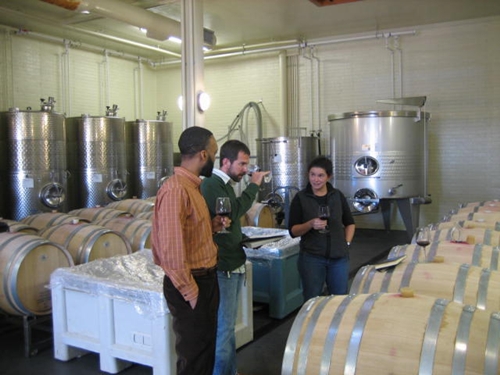
tasting wine from the barrels at Blenheim Vineyards
Our oak barrel story started in the forest then led us to the cooperage, and now it has led us to the bottle. After the barrel has gone through what can sometimes be a long creation process, it is time to fill it with wine. The topic of today’s post is what happens to that delicious wine while it is aging in the barrel.
TIME
The amount of time that a wine can spend in a barrel can vary drastically from months to several years. There are several factors that can influence how long a wine might be oak aged. The main factors are the grape itself (longer time for more hearty red varietals and shorter time for thinner skinned reds and whites), the age of the barrel (barrels that have been used several times will not impart the same amount of flavor as fresh barrels), the region that the wine is made (in some wine regions there are regulations around how long a wine type must spend in oak), and ultimately the experience of the winemaker taking into account all of the above will determine how long a wine spends aging in barrel.
CHEMICAL REACTIONS
Regardless of the time that the wine spends in the barrel, there are few things that can be happening to the juice. One thing that happens is the softening of the wine that is due to the minute amount of oxygen that seeps in through the staves, causing a more rapid ( but still fairly slow) binding of the tannins versus the wines being in an air tight container. The oak itself imparts its own flavors and aromas into the wine. Besides the obvious wood and tea flavors that come from the wood, vanilla (most commonly from American oak), clove, smoky and caramel aromas/flavors (as well as others) can come from the barrel maturation. Interestingly, the chemicals that provide the caramel aroma are generated during the toasting process. Two of these Maltol and Cyclotene have been shown to be flavor “accentuators”, helping to increase the presence of other flavors. This is similar to the role that MSG plays in many food products. The last role of the oak barrel that I will mention that some say is the most important, is its natural ability to clarify and stabilize the wine, decreasing and or removing the need for fining and filtering the wine. Now this list was in no particular order of importance nor is it an exhaustive list of what oak does to the wine, although it is pretty complete.
There are some great books out there than can go into great detail of the chemical reactions that are occurring inside a barrel that if you are a chemist can be quite fascinating.This completes the series on oak barrels. For the most part this has been pretty top level information on the process. If anyone has questions I will be happy to try and answer them or if anyone just wants to discuss what is currently going on the barrel market, just shoot me an email.
References – Oxford Companion to Wine, 3rd Edition, Jancis Robinson and The Wine Bible, Karen MacNeil




